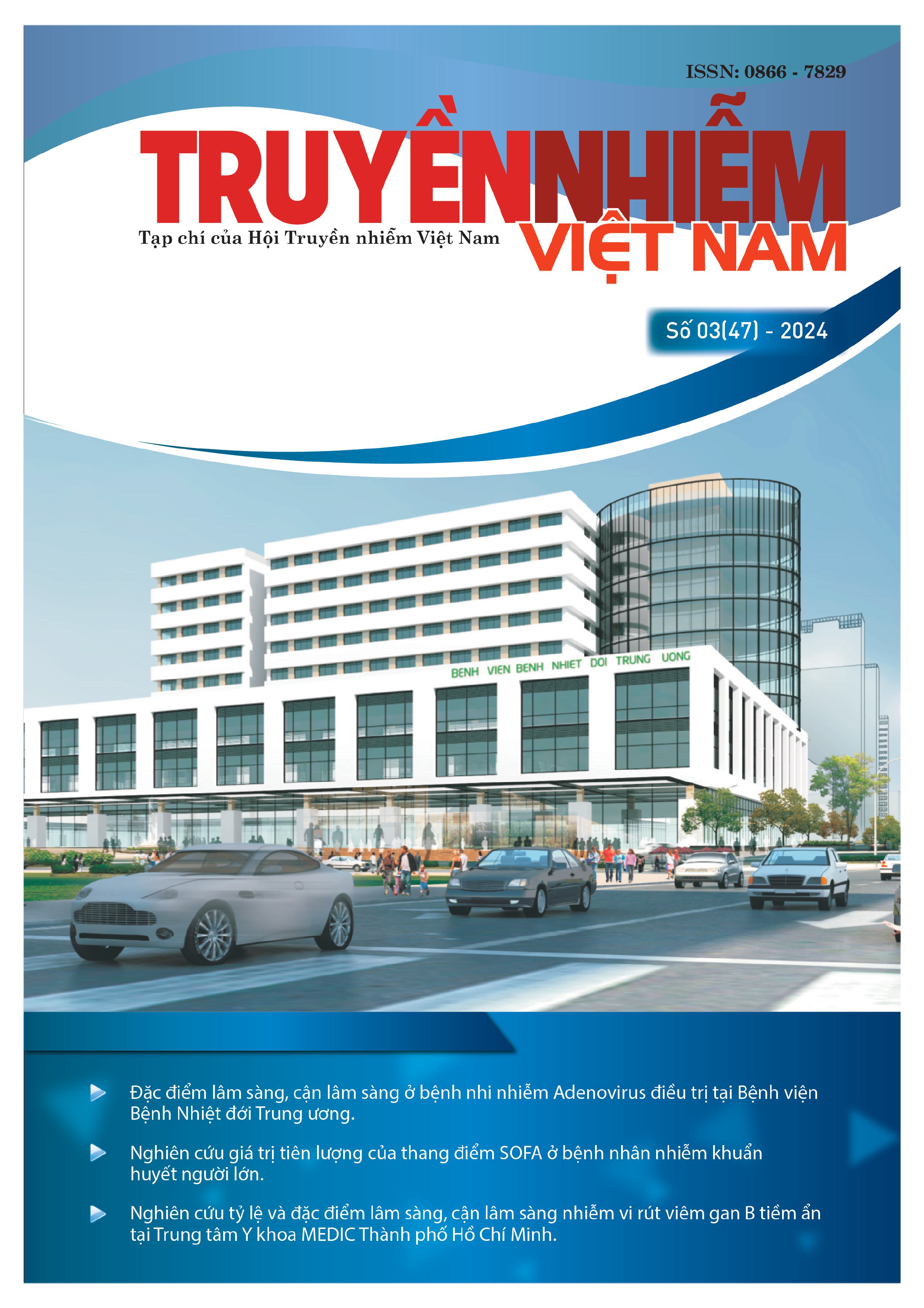STUDY ON THE CHARACTERISTICS AND EXTENT OF LIVER CELL DAMAGE IN ADULT PATIENTS WITH DENGUE HEMORRHAGIC FEVER AT HOAN MY CUU LONG GENERAL HOSPITAL IN 2023
Main Article Content
Abstract
Introduction: Dengue hemorrhagic fever is an infectious disease caused by the Dengue virus. Liver dysfunction is a common manifestation due to the direct effect of Dengue virus on liver cells or as a consequence of dysregulation of the immune response against Dengue virus. Elevated liver enzymes, such as aspartate transferase (AST) and alanine transferase (ALT) are indicative of liver function failure in Dengue hemorrhagic fever.
Objectives: Describe the characteristics and extent of liver cell damage in Dengue hemorrhagic fever adult patients at Hoan My Cuu Long General Hospital in 2023.
Methods: A cross-sectional, prospective descriptive study in Dengue hemorrhagic fever patients ≥ 16 years old. Liver cell damage is divided into 5 levels: Level 0 (no increase in liver enzymes), Level 1 (liver
enzymes increase < 5 times), Level 2 (liver enzymes increase 5 to < 10 times), Level 3 (liver enzymes increase ≥ 10 times), Level 4 (evidence of liver failure, liver-renal syndrome).
Results: From January 2023 to August 2023, 81 patients were studied. The average age was 34.08 ± 13.06 years old (16 - 83 years old), with 62.96% males and 37.04% females. Clinical features of the liver
included bleeding (37.04%), anorexia (11.11%), right upper quadrant pain (4.94%), hepatomegaly (2.47%), and no cases of mental disorders or jaundice. Median values of AST (U/L), ALT (U/L) by day of illness:
day 1 - 2 (46.84 and 39.74), day 3 - 4 (97.96 and 75.59), day 5 - 6 (163.60 and 109.06) and day 7 - 8 (131.59 and 110.96). Liver damage was categorized Level 1 (69.14%), Level 2 (13.58%), Level 3 (8.64%), Level
0 (8.64%) and level 4 (0.0%). The proportion of bleeding patients with Level 1 liver damage is higher than Level 2, Level 3 and Level 0 (73.33%; 23.33%; 10.0% and 3.33%), p = 0.620. The proportion of anorexia
patients with Level 1 liver damage is higher than Level 2 and Level 3 and Level 0 (66.67%; 22.22%; 11.11% and 0%), p = 0.679. The proportion of patients with mild, warning signs and severe Dengue hemorrhagic
fever with Level 1 liver damage (69.09%, 65.00% and 83.33%) is higher than Level 2 (14.55%, 15.00% and 0%), Level 3 (5.45%, 20.0% and 0%) and Level 0 (10.91%, 0% and 16.67%), p = 2.56.
Conclusions: Patients with Dengue hemorrhagic fever exhibited median AST and ALT values that gradually increase from days 1 - 2 to days 5 - 6, followed by a decrease from days 7 - 8 of the disease. Hepatocyte damage is mainly at Level 1. No correlation was found between clinical symptoms and the severity of the disease with the degree of liver cell damage.
Article Details
Keywords
Dengue hemorrhagic fever, liver cell damage
References
2. Bộ Y tế (2019), Hướng dẫn chẩn đoán, điều trị sốt xuất huyết Dengue. Quyết định số 3705/QĐ-BYT, ngày 22 tháng 8 năm 2019.
3. Trương Thị Hoa, Trần Xuân Chương (2023), "Nghiên cứu tổn thương gan ở bệnh nhân sốt xuất huyết Dengue ở người lớn". Tạp chí Truyền nhiễm Việt Nam, Tập 2 (số 42), trang 73-76.
4. Hoàng Vũ Hùng, Đỗ Thị Lệ Quyên (2014), "Một số đặc điểm lâm sàng, cận lâm sàng tổn thương gan ở bệnh nhân sốt xuất huyết Dengue người lớn". Tạp chí Y - Dược học Quân sự Số 4-2014.
5. Nguyễn Văn Minh (2019), Nghiên cứu đặc điểm lâm sàng, cận lâm sàng và đánh giá kết quả điều trị bệnh sốt xuất huyết Dengue người lớn tại Bệnh viện đa khoa trung tâm An Giang năm 2018 - 2019, Trường Đại học Y Dược Cần Thơ,
6. Đặng Thị Thúy, Bùi Vũ Huy, Đỗ Thị Thanh Thủy (2014), "Tổn thương gan trong bệnh sốt xuất huyết Dengue ở người trưởng thành". Tạp chí Nghiên cứu Y học, Tập 88 (số 3), trang 55-60.
7. Ageep AK (2012), "Degree of liver injury in Dengue virus infection". Journal of General and Molecular Virology, 4, pp: 1-5.
8. de Souza LJ, Nogueira R M, Soares LC, et al (2007), "The impact of Dengue on liver function as evaluated by aminotransferase levels". Braz J Infect Dis, 11 (4), pp: 407-10.
9. Lin CF, Wan SW, Chen MC, et al (2008), "Liver injury caused by antibodies against Dengue virus nonstructural protein 1 in a murine model". Lab Invest, 88 (10), pp:1079-1089.
10. Om P, Aysha A, SM Wasim J,et al (2010), "Severity of acute hepatitis and its outcome inpatients with Dengue fever in a tertiary care hospital Karachi, Pakistan (South Asia)". BMC Gastroenterolog, 10 (43), pp 2-8.
11. Dinh The Trung, Le Thi Thu Thao, Tran Tinh Hien, and et al (2010), "Liver involvement associated with Dengue infection in adults in Vietnam". Am J Trop Med Hyg, 83 (4), pp: 774-780.


